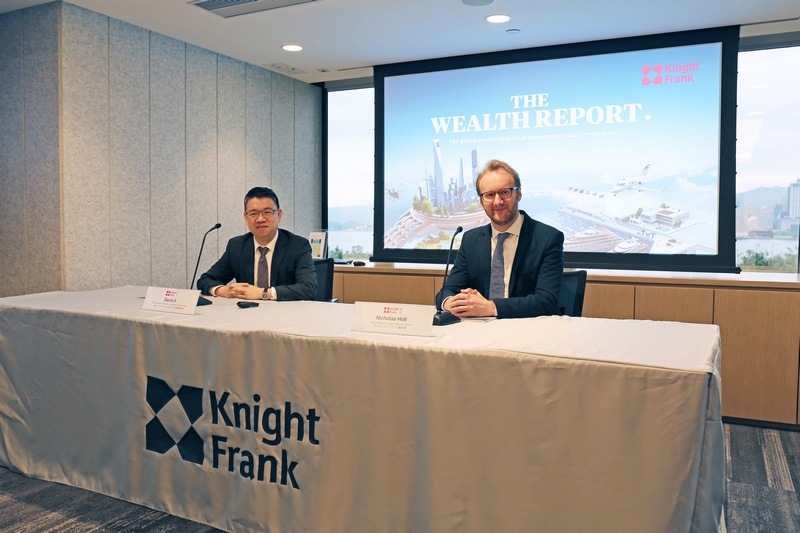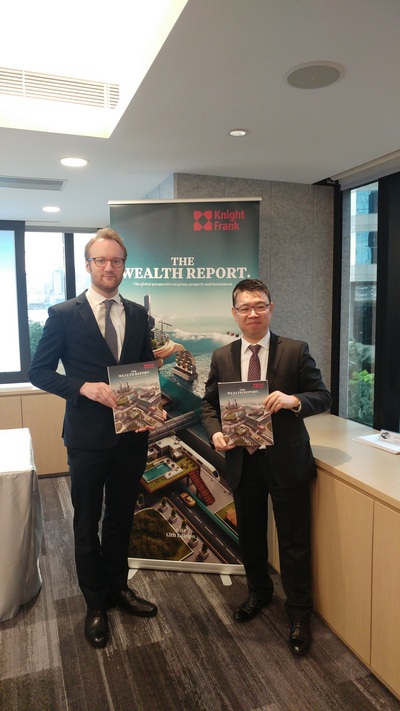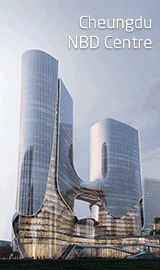(8 March 2018, Hong Kong) Knight Frank, the independent global property consultancy hosted a press conference this afternoon in Hong Kong launching The Wealth Report 2018. Now in its 12th year, this annual publication examines price performance data for 100 global luxury property markets as well as the Global Wealth Distribution and Knight Frank’s City Wealth Index. Headlines from the report include:
- In 2017, Asia overtakes Europe as home to the second largest population of ultra-wealthy people.
- In 2017, Japan tops in Asia with 9,960 ultra-wealthy individuals, follow by 8,800 on the Chinese Mainland and 5,140 in Hong Kong.
- The Mainland expects to see the strongest growth in ultra-wealthy population between 2017 and 2022.
- Hong Kong has the second highest density of ultra-wealthy population, with 70 ultra-wealthy individuals per 100,000 people.
- Hong Kong investors allocated 47% to property in their investment portfolio, ranked the highest in Asia.
- Hong Kong ranks the 9th overall in the Knight Frank City Wealth Index, which identify which cities that matter to the wealthy.
- Guangzhou leads the Prime International Residential Index (PIRI) ranking, recording over 27% increase in prime property prices year on year.
- Hong Kong’s luxury homes remain the second most expensive in the world for the 6th year in a row.
- Hong Kong expects to see the second strongest growth in prime residential flat prices in 2018.

Wealth distribution
The Wealth Report 2018 (Page 14)
Ultra-wealthy population (those with net assets of US$50 million or more)
- The number of ultra-wealthy people rose by 10% in 2017 – taking the global population to 129,730, with a combined worth of US$26.4 trillion.
- The ultra-wealthy population grew at a notably more rapid rate in 2017 than in the previous five years, when there was a cumulative 18% increase.
- The ultra-wealthy population in Asia will have grown by a further 55% to 55,740 by 2022.
- When looking at how specific ultra-wealthy population have fared between 2012 and 2017, the picture is mixed. While the Ultra-wealthy population rose in North America (+31%), Asia (+37%) and Europe (+10%), there were falls in the remaining five regions, most notably in Latin America and the Caribbean (-22%) and Russia and CIS (-37%).
- Asia (+37%) tops the ultra-wealthy population’s growth among world’s regions between 2012 and 2017, taking its total to 35,880 in 2017. In 2017, Japan tops in Asia with 9,960 ultra-wealthy individuals, follow by 8,800 in the Chinese Mainland and 5,140 in Hong Kong.
- Chinese Mainland expects to see the strongest growth in ultra-wealthy population between 2017 and 2022.
Regional Wealth Distribution
| Region | Ultra-wealthy (US$50m+) | % change | |||||
| 2012 | 2016 | 2017 | 2022 | 2012 – 2017 | 2016 -2017 | 2017-2022 | |
| Russia & CIS | 4,530 | 2,270 | 2,870 | 3,590 | -37% | 26% | 25% |
| Europe | 32,090 | 31,920 | 35,180 | 47,110 | 10% | 10% | 34% |
| Middle East | 4,880 | 4,610 | 4,740 | 6,040 | -3% | 3% | 27% |
| Australasia | 1,900 | 1,510 | 1,650 | 2,230 | -13% | 9% | 35% |
| Latin America & Caribbean | 5,380 | 3,510 | 4,220 | 5,470 | -22% | 20% | 30% |
| North America | 33,520 | 41,880 | 44,000 | 59,920 | 31% | 5% | 36% |
| Asia | 26,250 | 31,290 | 35,880 | 55,740 | 37% | 15% | 55% |
| Africa | 1,300 | 1,110 | 1,190 | 1,560 | -8% | 7% | 31% |
| TOTAL | 109,850 | 118,100 | 129,730 | 181,660 | 18% | 10% | 40% |
Source: Wealth-X, The Wealth Report 2018 (Page 14-15)
Country level wealth distribution of ultra-wealthy (US$50m+) – Top 15 Countries
| Country | 2012 | 2016 | 2017 | 2022 | 2012 -2017 | 2016-2017 | 2017-2022 |
| China, Mainland | 4,500 | 7,820 | 8,800 | 17,980 | 96% | 13% | 104% |
| Philippines | 250 | 300 | 310 | 570 | 24% | 3% | 84% |
| India | 1,890 | 2,420 | 2,920 | 4,980 | 54% | 21% | 71% |
| Nigeria | 260 | 210 | 200 | 340 | -23% | -5% | 70% |
| Indonesia | 1,080 | 1,050 | 1,160 | 1,930 | 7% | 10% | 66% |
| Malaysia | 330 | 280 | 310 | 510 | -6% | 11% | 65% |
| Belgium | 580 | 650 | 720 | 1,160 | 24% | 11% | 61% |
| Kenya | 50 | 80 | 90 | 140 | 80% | 13% | 56% |
| Sweden | 1,340 | 1,390 | 1,630 | 2,510 | 22% | 17% | 54% |
| Poland | 300 | 260 | 290 | 440 | -3% | 12% | 52% |
| Netherlands | 1,480 | 1,480 | 1,650 | 2,490 | 11% | 11% | 51% |
| Japan | 8,940 | 9,110 | 9,960 | 15,020 | 11% | 9% | 51% |
| Argentina | 260 | 240 | 300 | 450 | 15% | 25% | 50% |
| Romania | 190 | 210 | 240 | 360 | 26% | 14% | 50% |
| Czech Republic | 290 | 260 | 290 | 430 | 0% | 12% | 48% |
Source: Wealth-X
Nicholas Holt, Asia Pacific Head of Research, Knight Frank, says, “2017 was a relatively strong year for growth in Asia-Pacific, which has been reflected in the growth in the number of wealthy individuals across the region. Despite global headwinds such as a rising interest rate environment and tensions around trade, the region is set for further growth in 2018, with wealth increasingly being accumulated through new sources of growth including technology related industries.”
Wealth distribution – per capita perspective across Asia Pacific
While Hong Kong and Singapore are not forecast to see the kind of growth in the absolute number of ultra-wealthy individuals like that in Asia’s three largest economies: China, Japan and India. However, they still lead the way in wealth concentration in Asia Pacific in terms of the number of ultra-wealthy individuals per 100,000 people
In this particular category, Hong Kong with 70 and Singapore with 25 are respectively placed second and fourth globally., Monaco occupies the top position with 129 while Switzerland in the third position with 44.
Ultra-wealthy individuals (US$50m+) per 100,000 people across Asia Pacific
| Ranking | Country / territory | Ultra-wealthy individuals (2017) | Population
(2016) |
Ultra-wealthy individuals per 100,000 |
| 2 | Hong Kong | 5,140 | 7,346,700 | 69.96 |
| 4 | Singapore | 1,400 | 5,607,283 | 24.97 |
| 11 | Taiwan | 2,010 | 23,626,456 | 8.51 |
| 12 | New Zealand | 390 | 4,692,700 | 8.31 |
| 13 | Japan | 9,960 | 126,994,511 | 7.84 |
| 18 | Australia | 1,260 | 24,127,159 | 5.22 |
| 20 | South Korea | 2,610 | 51,245,707 | 5.09 |
| 31 | Thailand | 770 | 68,863,514 | 1.12 |
| 32 | Malaysia | 310 | 31,187,265 | 0.99 |
| 38 | Chinese Mainland | 8,800 | 1,378,665,000 | 0.64 |
Source: Wealth-X, World Bank, Worldometers, Knight Frank Research
 The Knight Frank City Wealth Index
The Knight Frank City Wealth Index
Source: The Wealth Report 2018, Page 28
Cities that matters to the wealthy
- The Knight Frank City Wealth Index uses four critical measures, including current wealth, investment, lifestyle and future wealth, to identify the cities that matter to the wealthy.
- On all measures, New York has topped the table in the 2018 City Wealth Index, London is second overall. Singapore tied with Chicago at fifth place. North American cities made up 10 of the top 20, with Asian cities occupying five spots.
- Hong Kong ranked 9th overall in the index, after Singapore on the 5th and Tokyo on the 8th.
Nicholas Holt, Asia-Pacific Head of Research, Knight Frank, says, “Asian cities took three of the top 10 spots in the City Wealth Index. Singapore’s standout ranking a reflection of its strong performance across all criteria. Tokyo and Hong Kong, the other Asian hubs that made the top grouping underlined their status as cities attracting attention from the world’s wealthy, with notable attention continuing to come from Chinese mainland investors.”
David Ji, Director and Head of Research & Consultancy, Greater China, says: “Last year Hong Kong continued to attract investors and investment from the Mainland where capital control was in place. Not only Hong Kong has become one of the key gateways of investment, it has now become the world’s biggest capital exporter.”
Knight Frank City Wealth Index 2018
| Overall rank | City | Wealth | Investment | Lifestyle | Future |
| 1 | New York | 1 | 1 | 1 | 1 |
| 2 | London | 4 | 2 | 5 | 2 |
| 3 | San Francisco | 5 | 4 | 2 | 6 |
| 4 | Los Angeles | 2 | 5 | 12 | 4 |
| 5 | Chicago | 6 | 18 | 3 | 8 |
| 5 | Singapore | 7 | 15 | 3 | 10 |
| 7 | Paris | 13 | 14 | 7 | 5 |
| 8 | Tokyo | 10 | 22 | 6 | 2 |
| 9 | Hong Kong | 3 | 3 | 10 | 25 |
| 10 | Washington DC | 12 | 10 | 7 | 13 |
| 11 | Sydney | 20 | 7 | 14 | 17 |
| 12 | Dallas | 9 | 6 | 35 | 9 |
| 13 | Boston | 24 | 13 | 21 | 7 |
| 14 | Houston | 8 | 15 | 29 | 14 |
| 14 | Miami | 19 | 8 | 19 | 20 |
| 16 | Atlanta | 20 | 10 | 24 | 15 |
| 17 | Beijing | 15 | 37 | 15 | 19 |
| 18 | Shanghai | 29 | 21 | 23 | 15 |
| 19 | Munich | 39 | 23 | 26 | 20 |
| 20 | Madrid | 52 | 25 | 9 | 24 |
| 20 | Melbourne | 44 | 15 | 25 | 26 |
Sources: Knight Frank, Macrobond, Wealth-X, New World Wealth, RCA, Oxford Economics, Five Star Alliance, Mastercard, Michelin, Times Higher Education, 2thinknow innovation cities index 2016-2017, The Wealth Report 2018 page 28
Attitudes Survey
Source: The Wealth Report 2018
The results of the Attitudes Survey offers an annual snapshot on the issues that are influencing wealthy individuals’ investment and lifestyle decisions. This year’s survey results are based on responses from 541 of the world’s leading private bankers and wealth advisors, representing roughly 50,000 clients with a combined wealth of around US$3 trillion.
Current allocation to property
When asked “what percentage of your clients’ investment portfolios is allocated to property (excluding primary residence and secondary homes)?” Hong Kong ranked highest in Asia at 47%. Singapore ranked lowest at 35%.
| Market | Property allocation in investment portfolio
(excluding primary residence and secondary homes) |
| Hong Kong | 47% |
| Australia | 46% |
| Malaysia | 44% |
| New Zealand | 43% |
| South Korea | 42% |
| Philippines | 42% |
| China | 36% |
| India | 36% |
| Singapore | 35% |
Source: The Wealth Report Attitudes Survey 2018
When it was a matter of investing in property in their home countries or abroad, Australians felt most comfortable staying home: respondents said 78% of their clients owned investment properties in Australia while only 17% had braved overseas markets. Malaysia held the second spot in both categories with 67% of clients investing locally and 47% abroad, with only Hong Kong at 49% tops the overseas investment table.
| Percentage of clients with domestic property investments (excluding primary residence and secondary homes) | Percentage of clients with international property investments (excluding primary residence and secondary homes) | |||
| Australia | 78% | Hong Kong | 49% | |
| Malaysia | 67% | Malaysia | 47% | |
| Singapore | 65% | Singapore | 37% | |
| New Zealand | 63% | China | 36% | |
| Hong Kong | 61% | India | 21% | |
| India | 58% | Philippines | 20% | |
| China | 55% | Australia | 17% | |
| Philippines | 52% | South Korea | 14% | |
| South Korea | 49% | New Zealand | 14% | |
Source: The Wealth Report Attitudes Survey 2018
| Market | Percentage of clients thinking of buying an investment property in next few years | |
| Domestically | Overseas | |
| Malaysia | 45% | 43% |
| Hong Kong | 42% | 40% |
| China | 37% | 37% |
| Singapore | 39% | 30% |
| Philippines | 45% | 21% |
| South Korea | 49% | 19% |
| India | 23% | 18% |
| Australia | 47% | 12% |
| New Zealand | 23% | 8% |
Source: The Wealth Report Attitudes Survey 2018
Top 5 destinations for new homes in 2018
| China | Hong Kong | Singapore | Malaysia | Australia |
| 1. US | 1.UK | 1. UK | 1. Australia | 1. US |
| 2. UK | 2. China | 2. Australia | 2. Singapore | 2. UK |
| 3. Australia | 2. Japan | 3. Japan | 3. UK | 3. New Zealand |
| 4. Hong Kong | 4. Australia | 3. Thailand | 4. US | 4. France |
| 5. Canada | 4. Canada | 3. US | 5. New Zealand | 5. Singapore |
Source: The Wealth Report Attitudes Survey 2018
Prime Residential Property
Prime International Residential Index (PIRI)
Source: The Wealth Report 2018, Page 34
This year, the PIRI tracks the movement in the price of luxury homes in 100 key locations worldwide. The index highlights the many factors playing out around the world that affect prime property markets.
Overall PIRI performance:
- In 2017, the overall index increased by 2.1%, compared with the 1.4% in 2016. This reflects the expansion of the global economy last year, when heightened political tensions were unable to dent growth.
- Of the 100 locations tracked by PIRI, two third recorded flat or rising prices in 2017. Eleven locations recorded double-digit growth.
- Guangzhou leads the rankings (+27%) but there has been a notable slowdown in China’s other first tier cities. Shanghai and Beijing only registered growth of just over 9% and almost 7% respectively.
- Seoul (13.2%) and Hong Kong (7.3%) continue to perform strongly, despite stringent cooling measures. Specifically, Hong Kong has risen to 17th place (up from 38th last year) in the index.
- David Ji, Director and Head of Research & Consultancy, Greater China, says: “Cities in Greater China took four of the top 20 spots in the PIRI. Guangzhou’s high ranking shows the very strong purchase demand in the city against a relatively weaker purchase restriction as across the nation policies are being tailored on each market. Ultra-wealthy people was keen on seeking after residential property as a way to store their wealth, particularly as a tool to counter inflation and as one of the key methods of investment.
The PIRI – Annual change in prime prices to Dec 2017
| No. | Location | World Region | Annual % change
(Dec 16 – Dec 17) |
|
| 1 | Guangzhou | Asia | 27.4% | |
| 2 | Cape Town | Africa | 19.9% | |
| 3 | Aspen | North America | 19.0% | |
| 4 | Amsterdam | Europe | 15.0% | |
| 5 | Seoul | Asia | 13.2% | |
| 6 | Frankfurt | Europe | 12.9% | |
| 7 | Seattle | North America | 12.2% | |
| 8 | Paris | Europe | 12.0% | |
| 9 | Sydney | Australasia | 10.7% | |
| 10 | Madrid | Europe | 10.6% | |
| 11 | Munich | Europe | 10.0% | |
| 12 | Buenos Aires | Latin America | 9.9% | |
| 13 | Berlin | Europe | 9.9% | |
| 14 | Melbourne | Australasia | 9.8% | |
| 15 | Shanghai | Asia | 9.2% | |
| 16 | Toronto | North America | 8.7% | |
| 17 | Hong Kong | Asia | 7.3% | |
| 18 | Barcelona | Europe | 7.2% | |
| 19 | Mexico City | Latin America | 6.9% | |
| 20 | Beijing | Asia | 6.7% |
Source: The Wealth Report 2018, Page 35
All data comes from Knight Frank’s global network with the exception of Tokyo (Ken Corporation); São Paulo and Rio de Janeiro (Fundação Instituto de Pesquisas Econômicas); Oslo (Torbjørn Ek); Boston, Chicago, San Francisco, Los Angeles,
Miami, New York, Seattle and Washington DC (S&P CoreLogic Case-Shiller); Barcelona (Ministerio de Fomento); Tel Aviv (Israel Central Bureau of Statistics); Jersey (States of Jersey); Berlin and Frankfurt (Immobilien Scout24); Mexico (Sociedad
Hipotecaria Federal); Cape Town and Johannesburg (First National Bank); Stockholm (Svensk Mäklarstatistik).
Notes: All price changes relate to local currency. Data for Aspen, Barcelona, Tel Aviv and Tokyo relates to the period from Sept 2016 to Sept 2017. Data for Boston, Chicago, Los Angeles, Miami, New York, San Francisco, Seattle and Washington DC relates to the period Oct 2016 to Oct 2017. Data for Abu Dhabi, Berlin, Cape Town, Dubai, Frankfurt, Rio de Janeiro, São Paulo and Toronto relates to the period from Nov 2016 to Nov 2017. The price change for Tokyo relates to all properties above ¥100m. The price change for Bali relates to leasehold properties only. Data for Cape Town relates to the Atlantic Seaboard and data for Johannesburg relates to Sandton.
Hong Kong’s luxury homes remain the second most expensive in the world
Source: The Wealth Report 2018, Page 38
Monaco – for the 11th consecutive year – is confirmed as the most expensive city to buy luxury residential property, with US$1m buying just 16 square metres of accommodation. Not far behind, are Hong Kong and New York occupying second and third. US$1m would buy 22 and 25 square metres, respectively.
RELATIVE VALUES: How many square metres of prime property US$1m buys across the world
| City | Square Metres |
| Monaco | 16 |
| Hong Kong | 22 |
| New York* | 25 |
| London | 28 |
| Singapore | 39 |
| Geneva | 41 |
| Paris | 46 |
| Sydney | 48 |
| Shanghai | 54 |
| Los Angeles* | 58 |
| Beijing | 66 |
| Tokyo | 76 |
| Berlin | 77 |
| Miami | 78 |
| Melbourne | 90 |
| Mumbai | 92 |
| Istanbul | 98 |
| Dubai | 138 |
| Cape Town | 157 |
| São Paulo | 173 |
Source: Knight Frank Research, Douglas Elliman, Ken Corporation.
* New developments only
All data Q4 2017 based on exchange rate on 31 Dec 2017
Prime residential price forecast
Forecast change in prime residential values (Dec 17 – Dec 18)
| City | Forecast |
| Paris | 9.0% |
| Hong Kong | 7-8.0% |
| Berlin | 7.0% |
| Sydney | 7.0% |
| Singapore | 5.0% |
| Madrid | 5.0% |
| Geneva | 3.0% |
| Los Angeles | 3.0% |
| Mumbai | 2.0% |
| Dubai | 1.0% |
| London | 0.5% |
Source: Knight Frank Research, The Wealth Report (Page 40)
Looking forward, Hong Kong is expected to see the second strongest growth in prime residential flat prices of 7-8% on average year-on-year in 2018, followed by 9.0% increase in Paris.
To download the report, please visit:
http://www.knightfrank.com/wealthreport
http://www.knightfrank.com/resources/wealthreport2018/the-wealth-report-2018.pdf












